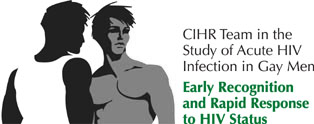
Funding Provided By
Welcome to the Acute HIV Infection in Gay Men website! Our study was funded by the Canadian Institutes of Health Research and ran between 2009 and 2013 and looked at the impact of introducing a new type of HIV testing that detects HIV very early after infection (during the acute phase), called pooled Nucleic Acid Amplification Testing (NAAT). If diagnosed early, someone can start HIV treatment right away which leads to the best clinical outcomes. The acute phase of infection is also a time when levels of the HIV virus in the blood (called HIV viral load) is very high, and there is a higher chance of passing HIV to someone else. As most individuals diagnosed with HIV take measures to prevent passing HIV and starting treatment reduces HIV viral load, increasing the capacity for early HIV diagnosis can have an important public health impact and reduce new infections.
However, we weren’t just interested in whether introducing pooled NAAT in Vancouver led to earlier HIV diagnoses. We also wanted to understand how this new testing technology affected the lived experiences of gay men diagnosed with early infections - both at the time of diagnosis and in the years following their diagnosis. We also wanted to understand how HIV testing (and this test in particular) fit as one component of how HIV negative gay men thought about their overall health. We did this by recruiting gay men to participate in two cohorts: an HIV-positive cohort for gay men recently diagnosed with HIV (including during the acute phase), and an HIV-negative cohort of gay men who recently tested negative. We used data collected from interviews, questionnaires and HIV testing specimens. Gay men were meaningfully involved in this study team, in leadership roles, as study staff and community partners. These men played key roles in data analysis, interpretation, and publication of findings.
What did we find? Here’s a few highlights from our research:
- Access to and promotion of pooled NAAT testing is an important public health intervention for gay men, leading to more frequent testing, earlier diagnosis, and changes in behavior which reduce the chance of passing HIV to others. \
- Many of the HIV-positive men we interviewed talked about milestones relating to initiating medication and changes in viral load as informing their shifting sexual behaviors and identities as HIV-positive (or "undetectable") gay men.
- The men we interviewed were concerned about their health and the health of their sexual partners. Nearly all of our HIV-positive participants described an initial period of refraining from sex after their HIV diagnosis, although the length of time varied. The HIV-negative men we interviewed described nuanced understandings of sexual safety. Many men did not consider sex without condoms to always be risky, and they provided insights into the situations and relationships in which HIV prevention strategies that don't involve condoms are currently being used.
We’ve prepared two summary reports from both cohorts of gay men that describe these and many other findings. You can also find links to our other publications on the Study Findings page.
 |
 |
 |
||
 |
||||
